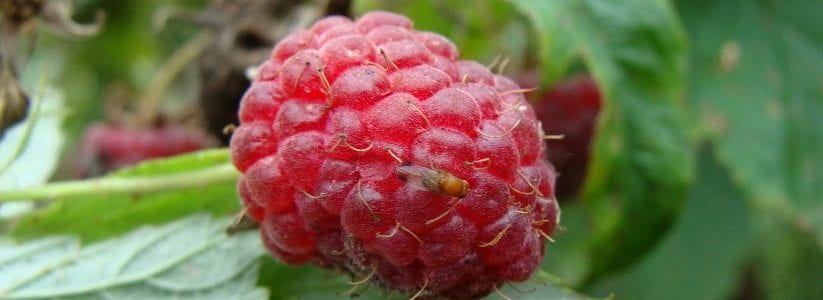Blueberry plantings in Herkimer and Wayne Counties have reached first catch as of July 13 and 14, respectively. Three SWD, 2 male and 1 female, were caught in four jar traps set in and on the edge of a blueberry planting in Herkimer County. Three male SWD were caught on a sticky trap, none on the other sticky trap or in the two jar traps, all set on the edge of the planting in Wayne County.

As blueberry season gears up, SWD will take advantage of this crop as a reproductive resource. Keep those tiny, white worms out of your fruit with consistent SWD management tactics. For blueberries, here's a refresher of resources:
Managing SWD in blueberries from the NYS IPM Program, blogs.cornell.edu/swd1/2019/08/02/managing-swd-in-blueberries/ .
Spotted Wing Drosophila IPM in Blueberries from the NE IPM Center SWD Working Group, neipmc.org/go/swdpub2
SWD Management entails 5 key tactics:
- Excellent sanitation will reduce SWD populations.
Fruit should be harvested frequently and completely to prevent the buildup of ripe and over-ripe fruit. Unmarketable fruit should be removed from the field and either frozen, “baked” in clear plastic bags placed in the sun, or disposed of in bags off-site. This will kill larvae, remove them from your crop, and prevent them from emerging as adults.
- Canopy and water management will make the environment less favorable.
Prune to maintain an open canopy, increase sunlight and reduce humidity. This will make plantings less attractive to SWD and will improve spray coverage. Repair leaking drip lines and avoid overhead irrigation when possible. Allow the ground and mulch surface to dry before irrigating.
- Insecticide sprays will kill SWD adults and thereby reduce egg laying.
Insecticide treatments should begin when either regional monitoring alerts about the first SWD trap catch or when highly susceptible fruit crops, such as raspberries and blackberries, are ripening. Treatments should be applied at least every seven days and repeated in the event of rain. Choose the most effective insecticides with pre harvest intervals that work for your picking schedule. Rotate insecticides according to their modes of action. Quick reference guides are on the SWD Management web page, fruit.cornell.edu/spottedwing/management/. Check the Cornell Guidelines for your crop (cropandpestguides.cce.cornell.edu/) for the latest list of approved pesticides. Always read and follow the pesticide label instructions.
- Regular fruit sampling.
At least 100 fruit per block per harvest should be observed for infestation. Talk to your local CCE agent about a monitoring program. Fruit can be inspected for evidence of larval feeding. Small holes in berries where the eggs were laid may leak juice when the berry is gently squeezed; this is especially diagnostic on blueberry. Infested red raspberry fruit may leave a red juice stain on the berry receptacle when the fruit is picked. Fruit with small indents or bruises where the berry surface appears to have flattened or deflated may be damaged.
A salt flotation method, immersing fruit in a solution of 1 Tbsp. (14.8 cc) table salt per 1 cup (236.6 ml) water, may cause larvae to float to surface. At least 100 fruit per block per harvest should be observed for infestation. Suggested methods were adapted for NY growers in Guidelines for Checking Fruit for SWD Larvae in the Field.
- Cool berries immediately.
Chilling berries immediately after harvest to 32°F–34°F will slow or stop the development of larvae and eggs in the fruit. U-Pick customers should be encouraged to refrigerate fruit immediately to maintain fruit quality at home.
IPM reminders to level the playing field against SWD
- Mow your fruit plantings, orchards and vineyards.
- Control weeds within the row.
- Prune back shady hedgerows and wooded edges.
- Prune to open the canopy.
- Calibrate your sprayer.
- Rotate IRAC modes of action.
- Immediately put the fresh fruit harvest into cold storage, 33°F-34°F can kill SWD eggs and larvae in fruit.
Traps in Herkimer County are being maintained by the blueberry grower and insect identification is done by Juliet Carroll, NYS IPM Program. Traps in Wayne County are being monitored by Juliet Carroll, NYS IPM.

